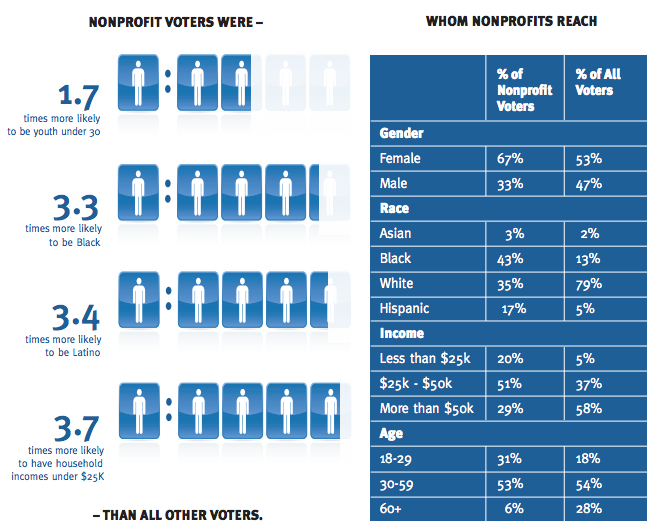Nonprofit Organizations Significantly Increase Voter Turnout

Nonprofit VOTE examined the impact of nonprofit organizations on voter behavior within seven states in an August 2013 study. It found that those contacted by a nonprofit organization -- in regards to the election -- turned out at 74 percent while 68 percent of all registered voters turned out.
The data from the study suggests that nonprofit organizations fight an uphill battle when trying to increase turnout since their target audience has a historically low propensity to vote.
However, nonprofits made the most significant impact on closing the turnout gap within age, ethnic, and income demographics. Voter turnout of nonprofit voters (those who engaged with a nonprofit) compared to all registered voters was:
- 18 points higher for Latino voters (72% vs. 54%),
- 15 points higher for voters under the age of 30 (68% vs. 53%), and
- 15 points higher for voters with household incomes under $25,000 (68% vs. 53%).
The type of engagement a nonprofit has with a potential voter can be an indicator of propensity to vote. Registered voters who pledged to vote with a nonprofit turned out at 77 percent, while those who were engaged to register to vote turned out at 68 percent.
The study also asserts the effectiveness of voter engagement:
"This speaks broadly to the power of personal contact in mobilizing people to vote. More specifically it affirms the impact of the personal contact coming from someone or an organization known to and trusted by the voter."
Nonprofit organizations play a large role in voter education and improving the political process with more participation. They may be filling the void of voter information that the commercial media, government, and advertising campaigns fall short to provide.
However, it would be a mistake to jump to the conclusion that nonprofits' role to increase voter turnout immediately equates to better representation. Variables such as the pool of candidates, the system in which they were chosen, and a sometimes limited discourse are still factors in effective representation. Still, an increase in voter turnout is a positive result.
The study was conducted in seven states for the 2012 general election; Arizona, Massachusetts, Michigan, Minnesota, North Carolina, New Jersey, and Ohio. Within those states, 94 nonprofit organizations had 33,741 voters as part of the Track the Vote program. Results from nonprofit voters was contrasted with overall registered voters in these states.
Have you been contacted by a nonprofit organization for voter information? Was it helpful for casting a more informative vote?
(The entire study by Nonprofit VOTE can be read or downloaded here.)
Image credit: Nonprofit VOTE Facebook Page




